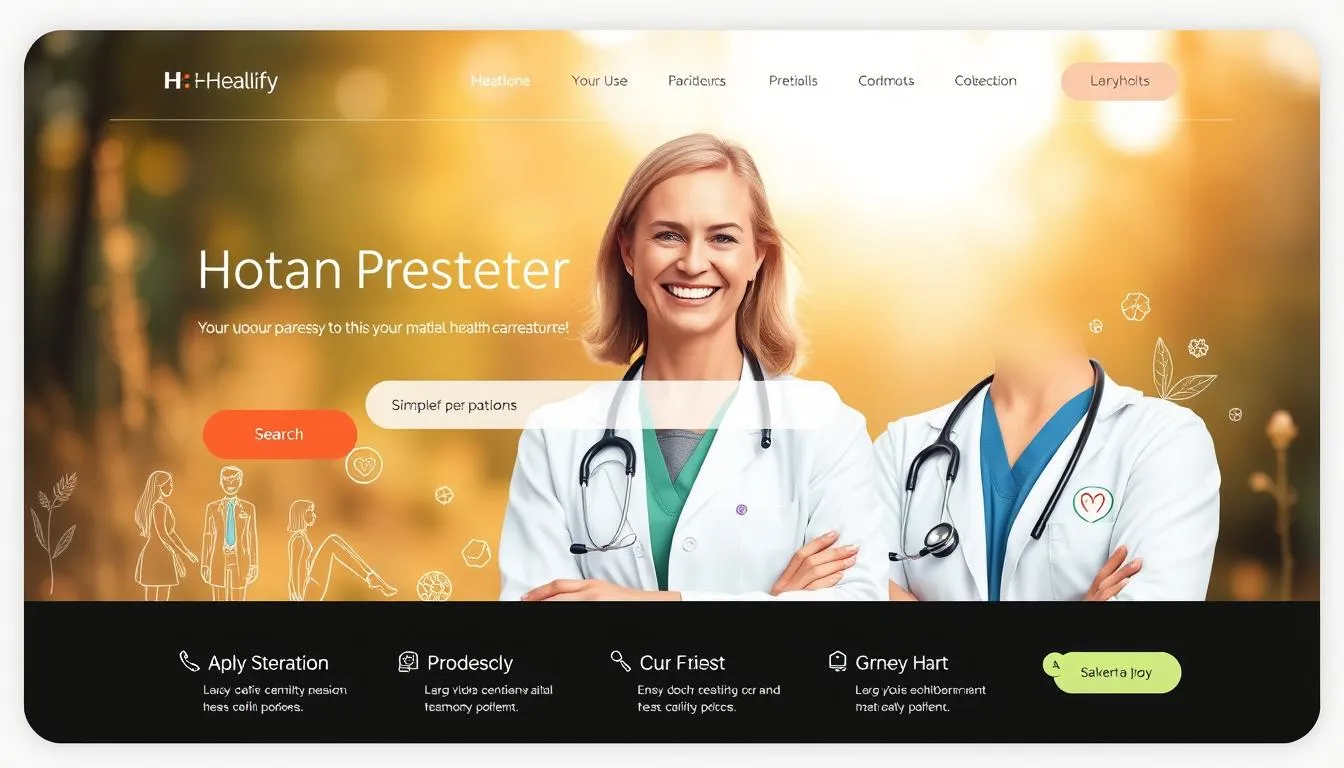Last Updated on: June 19, 2025
Creating a patient-friendly healthcare website is crucial in today’s digital age. A well-designed website can significantly enhance the patient experience, making it easier for individuals to access the information and services they need.
A healthcare website design that prioritizes patient needs can lead to increased patient engagement and satisfaction. It is essential to consider the unique requirements of healthcare consumers when designing a website.
Key Takeaways
- Understand your target audience’s needs and preferences.
- Prioritize clear navigation and accessible information.
- Ensure your website is mobile-friendly and secure.
- Regularly update and maintain your website’s content.
- Regularly update and maintain your website’s content.
Understanding the Unique Needs of Healthcare Website Users
Understanding the complex needs of healthcare website users is crucial for creating a user experience that is both intuitive and supportive. Healthcare websites serve as a critical touchpoint for patients seeking information, services, and support.
Patient Demographics and Digital Literacy Levels
Patient demographics play a significant role in shaping the user experience of healthcare websites. Different age groups, for instance, have varying levels of digital literacy.
Age-Related Considerations in Healthcare UX Design
Older adults may require larger font sizes and simpler navigation due to decreased visual acuity and less familiarity with digital interfaces.
Accommodating Various Technical Proficiency Levels
Designing for different technical proficiency levels involves creating intuitive interfaces that are easy to navigate, regardless of the user’s experience with technology.
Common Patient Goals When Visiting Healthcare Websites
Patients visit healthcare websites with various goals in mind, ranging from seeking information about medical conditions to accessing healthcare services.
Information Seeking vs. Service Access Behaviors
Some patients may be looking for detailed information about their health conditions, while others may be seeking to schedule appointments or access their medical records.
Emotional States During Healthcare Website Visits
Patients may experience a range of emotions when visiting healthcare websites, from anxiety about their health to frustration with complex navigation.
Essential Elements of User Experience in Healthcare Web Design
Intuitive and user-friendly healthcare websites are essential for guiding patients through their medical journey. A well-designed website can significantly enhance the patient experience, providing easy access to medical information and services.
Intuitive Navigation Systems for Medical Information
An intuitive navigation system is crucial for healthcare websites, allowing patients to quickly find the information they need. This can be achieved by using clear and concise menu labels, categorizing content logically, and providing a robust search function.
- Clear menu labels that reflect common patient queries
- Logical categorization of medical services and specialties
- A prominent search bar to facilitate quick information retrieval
Reducing Cognitive Load for Stressed or Ill Users
Patients visiting healthcare websites are often under stress or experiencing health issues, making it essential to reduce cognitive load. Simplifying complex medical concepts and using clear call-to-action strategies can significantly enhance the user experience.
Simplifying Complex Medical Concepts Visually
Visual aids such as infographics, diagrams, and videos can help simplify complex medical information, making it more accessible to patients.
Clear Call-to-Action Strategies for Patient Guidance
Clear call-to-action (CTA) buttons and links guide patients through the website, helping them find the information or services they need. CTAs should be prominent, concise, and actionable.
- Use action-oriented language for CTAs, such as “Schedule an Appointment”
- Ensure CTAs are visually distinct and placed prominently on the page
- Use CTAs consistently throughout the website to maintain a cohesive user experience
How to Design a Healthcare Website That Is Patient-Friendly? Core Principles
To design a healthcare website that truly caters to patients, one must first grasp the intricacies of their needs and the obstacles they face. A patient-friendly healthcare website is not just about presenting information; it’s about creating an experience that is both comforting and empowering for the patient.
Empathy-Driven Design Approaches
Empathy-driven design is at the heart of creating a patient-friendly healthcare website. This involves understanding the patient’s journey and identifying pain points in their digital healthcare experience.
Patient Journey Mapping Techniques
Patient journey mapping is a powerful tool that allows healthcare providers to visualize the patient’s experience across multiple touchpoints. By doing so, they can identify areas where the patient may encounter difficulties or frustrations.
Addressing Pain Points in the Digital Healthcare Experience
Once pain points are identified, healthcare websites can be designed to address these issues directly. For example, simplifying the appointment scheduling process or providing clear instructions for patient portals can significantly enhance the patient experience.
Balancing Clinical Accuracy with Approachability
Healthcare websites must strike a delicate balance between providing clinically accurate information and presenting it in an approachable manner. Using clear language, avoiding jargon, and incorporating visual aids can make complex medical information more accessible to patients.
By incorporating these core principles, healthcare websites can become more patient-friendly, ultimately leading to a better experience for those seeking medical information or services online.
Creating Accessible Healthcare Websites for All Users
Creating an accessible healthcare website is not just a legal requirement, but a moral imperative to serve diverse patient needs. Ensuring that healthcare websites are accessible to everyone, including individuals with disabilities, is crucial for providing equal access to medical information and services.
ADA Compliance Requirements for Medical Websites
The Americans with Disabilities Act (ADA) mandates that websites, including those in the healthcare sector, must be accessible to people with disabilities. Compliance with ADA guidelines is not only a legal necessity but also enhances the user experience for a broader audience.
WCAG2.1 Guidelines for Healthcare Sites
The Web Content Accessibility Guidelines (WCAG) 2.1 provide a comprehensive framework for making web content more accessible. For healthcare websites, adhering to these guidelines is crucial. Some key recommendations include:
- Ensuring all non-text content has a text alternative.
- Making all functionality available from a keyboard.
- Providing enough time for users to read and use content.
Accessibility Testing Tools and Methods
To ensure compliance with accessibility standards, healthcare websites should undergo regular testing using various tools and methods, including automated testing tools and user testing with assistive technologies.
Designing for Users with Disabilities and Impairments
Designing healthcare websites with users with disabilities in mind involves several key considerations, including screen reader optimization and color contrast standards.
Screen Reader Optimization Techniques
Optimizing for screen readers involves ensuring that content is structured in a logical and accessible manner. Techniques include using proper heading structures and providing alternative text for images.
“The power of the Web is in its universality. Access by everyone regardless of disability is an essential aspect.” – Tim Berners-Lee
Color Contrast and Visual Accessibility Standards
Ensuring sufficient color contrast between the background and text is crucial for visual accessibility. Standards recommend a contrast ratio of at least 4.5:1 for normal text.
By prioritizing accessibility and adhering to guidelines like WCAG2.1, healthcare websites can ensure they are usable by the widest range of users, including those with disabilities.
Content Strategy That Builds Patient Trust and Confidence
A well-crafted content strategy is essential for healthcare websites aiming to build patient trust. By focusing on clear communication, showcasing provider expertise, and leveraging patient testimonials, healthcare organizations can create a trustworthy online presence.
Writing Clear Medical Information for Lay Audiences
Clear medical information is vital for helping patients understand their health conditions and treatment options. Healthcare providers should use simple, straightforward language when explaining complex medical concepts. Avoiding jargon and technical terms can make a significant difference in patient comprehension. As noted by a healthcare expert,
“The way you communicate with patients can be just as important as the treatment you provide.”
Showcasing Provider Credentials and Expertise Effectively
Showcasing provider credentials is crucial for establishing credibility. This can be achieved by including detailed physician profiles that highlight their qualifications, specialties, and experience. Effective physician profiles not only build trust but also help patients make informed decisions about their care.
Physician Profile Best Practices
To create effective physician profiles, consider including:
- Professional background and education
- Specialties and areas of expertise
- Patient reviews and testimonials
Integrating Patient Testimonials Ethically
Patient testimonials can be a powerful tool for building trust. However, it’s essential to integrate them ethically. Ensure that testimonials are genuine, obtain patient consent before publishing, and avoid manipulating the content to mislead potential patients.
Information Architecture for Intuitive Patient Navigation
Effective information architecture is the foundation upon which intuitive patient navigation is built, enhancing the overall user experience on healthcare websites. A well-structured information architecture ensures that patients can easily locate the information they need, thereby reducing anxiety and improving their overall interaction with the healthcare provider.
Organizing Medical Services and Specialties Logically
Organizing medical services and specialties in a logical manner is crucial for facilitating easy navigation. This involves categorizing services into clear and understandable groups, using simple and consistent labeling that resonates with patient needs and expectations. For instance, services can be grouped by type (e.g., cardiology, pediatrics), by condition (e.g., diabetes management, mental health), or by the type of care provided (e.g., emergency services, preventive care).
According to Jakob Nielsen, a pioneer in usability, “users spend most of their time on other websites, and they prefer your site to work the same way as all the other sites they already know.” This principle underscores the importance of intuitive navigation and familiar categorization in healthcare websites.
Creating Clear Pathways to Critical Information
Creating clear pathways to critical information is another vital aspect of information architecture. This involves identifying the most critical information that patients need and ensuring that it is easily accessible from the homepage or main navigation menu. Critical information may include emergency contact details, appointment scheduling processes, or insurance information.
Emergency Information Accessibility Standards
Ensuring that emergency information is readily accessible is a critical requirement. This can be achieved by providing a clear and prominent link to emergency information on the website’s homepage and relevant pages. The content should be concise, clear, and easily understandable, providing patients with the necessary information during emergencies.
Insurance and Payment Information Organization
The organization of insurance and payment information is also crucial for patient navigation. This information should be clearly presented, including details on accepted insurance plans, payment options, and any out-of-pocket costs associated with services. Transparency in this area helps build trust with patients and reduces financial stress related to healthcare costs.
As Healthcare Information and Management Systems Society (HIMSS) emphasizes, “patient engagement is a critical component of healthcare delivery,” and clear information architecture plays a significant role in this engagement.
Security, Privacy, and Compliance in Healthcare Website Design
Compliance with healthcare regulations is not just about avoiding penalties; it’s about building a trustworthy online presence. Healthcare websites handle sensitive patient information, making security, privacy, and compliance crucial elements of their design.
HIPAA-Compliant Design Patterns and Features
To ensure HIPAA compliance, healthcare websites must incorporate specific design patterns and features. This includes secure forms and data collection methods that protect patient information from unauthorized access.
Secure Forms and Data Collection Methods
Secure forms are essential for collecting patient data without compromising their privacy. This can be achieved through the use of HTTPS encryption and ensuring that all data collection processes are thoroughly vetted for security vulnerabilities.
Privacy Policy Communication Strategies
Clearly communicating privacy policies is vital for building patient trust. Healthcare websites should provide easily accessible privacy policies that explain how patient data is used and protected.
Building Trust Through Visible Security Measures
Visible security measures play a significant role in building patient trust. By displaying trust badges and security certifications, healthcare websites can reassure patients that their information is secure.
Furthermore, implementing robust security protocols, such as two-factor authentication and regular security audits, can further enhance trust. It’s also important to keep patients informed about the measures in place to protect their data.
Implementing Patient-Centered Interactive Features
Patient-centered interactive features are revolutionizing the way healthcare websites engage with users. By incorporating intuitive and user-friendly elements, healthcare providers can significantly enhance the patient experience, fostering a more positive and interactive relationship.
Designing Intuitive Appointment Scheduling Interfaces
An intuitive appointment scheduling interface is crucial for allowing patients to easily book appointments online. Clear instructions and minimal steps are key to reducing patient frustration and increasing the likelihood of successful scheduling. For instance, a simple, multi-step process with clear prompts can guide patients through the scheduling process efficiently.
- Provide a clear calendar interface for selecting appointment dates and times.
- Offer real-time availability to minimize scheduling conflicts.
- Include a confirmation step to ensure accuracy.
Patient Portal Usability Best Practices
Patient portals are a critical component of modern healthcare websites, offering patients secure access to their medical records and the ability to communicate with healthcare providers. Ensuring these portals are user-friendly is paramount.
Medical Record Access Interface Design
The design of the medical record access interface should prioritize clarity and simplicity. Patients should be able to easily navigate their records, understanding the information presented without confusion.
“A well-designed patient portal can significantly improve patient engagement and satisfaction by providing timely and secure access to medical information.” – Healthcare IT Expert
Secure Messaging Systems Between Patients and Providers
Secure messaging systems allow patients to communicate directly with healthcare providers, ask questions, and receive timely responses. Ensuring the security and privacy of these communications is critical, with clear indicators of message status (e.g., read, unread, responded) enhancing usability.
By focusing on these patient-centered interactive features, healthcare websites can improve patient satisfaction, enhance engagement, and provide a more personalized experience.
Visual Design Elements That Enhance the Patient Experience
Visual elements are key to making a healthcare website both accessible and engaging for patients. A well-crafted visual design can significantly enhance the overall user experience, making it easier for patients to find the information they need and navigate the site.
“A visually appealing website is not just about aesthetics; it’s about creating an environment that makes patients feel comfortable and supported,” says a leading healthcare design expert. This approach is crucial in healthcare, where the website’s design can directly impact patient trust and satisfaction.
Color Psychology in Healthcare Website Design
The strategic use of color is a critical aspect of visual design in healthcare websites. Different colors can evoke various emotions and reactions from patients. For instance, calming colors like blue and green can help reduce anxiety, while more vibrant colors can be used to draw attention to important information.
When selecting a color palette, healthcare providers should consider the emotional and psychological impact of their choices. Colors should be used consistently across the website to create a cohesive and recognizable brand identity.
Using Imagery That Reflects Patient Diversity and Comfort
Imagery plays a vital role in making a healthcare website feel inclusive and welcoming. Using images that reflect the diversity of the patient population can help individuals feel seen and understood. This includes using photos of people from different ethnic backgrounds, ages, and abilities.
Moreover, the imagery should convey a sense of comfort and care. Images of compassionate healthcare providers, serene environments, and moments of patient-provider interaction can help foster a positive emotional connection with the website.
Conclusion: Building a Healthcare Website That Truly Serves Patients
Designing a patient-friendly healthcare website requires a deep understanding of the unique needs of healthcare website users. By incorporating essential elements of user experience, creating accessible websites, and implementing patient-centered interactive features, healthcare providers can build trust and confidence with their patients.
A well-designed healthcare website should prioritize intuitive navigation, clear medical information, and visible security measures. By balancing clinical accuracy with approachability, healthcare providers can create a website that truly serves patients. Effective healthcare website design principles include empathy-driven design approaches, ADA compliance, and a focus on patient needs.
By following these principles, healthcare organizations can create a patient-friendly healthcare website that enhances the patient experience, improves health outcomes, and sets a new standard for healthcare website design. A patient-friendly healthcare website is not just a necessity, it’s an opportunity to showcase a healthcare provider’s commitment to patient care and satisfaction.
FAQ
What are the key elements of a patient-friendly healthcare website?
A patient-friendly healthcare website should have intuitive navigation, clear and concise content, and be accessible on various devices. It should also prioritize patient needs, be designed with empathy, and provide a secure and private experience.
How can healthcare websites be made more accessible?
To make healthcare websites more accessible, they should comply with ADA requirements and WCAG2.1 guidelines. This includes using clear and simple language, providing alternative text for images, and ensuring that the site can be navigated using a screen reader.
What is the importance of HIPAA compliance in healthcare website design?
HIPAA compliance is crucial in healthcare website design to ensure the security and privacy of patient data. This includes using secure forms and data collection methods, encrypting sensitive information, and providing clear privacy policies.
How can healthcare websites build trust with patients?
Healthcare websites can build trust with patients by showcasing provider credentials and expertise, integrating patient testimonials ethically, and providing clear and concise medical information. Visible security measures, such as SSL certificates, can also help to establish trust.
What are some best practices for designing patient portals?
Best practices for designing patient portals include creating intuitive interfaces, providing clear and concise information, and ensuring secure messaging systems between patients and providers. Patient portals should also be designed with accessibility in mind.
How can visual design elements enhance the patient experience?
Visual design elements, such as color psychology and imagery, can enhance the patient experience by creating a welcoming and comforting atmosphere. Imagery should reflect patient diversity and promote comfort, while color psychology can be used to create a calming and professional tone.
What is the role of information architecture in healthcare website design?
Information architecture plays a critical role in healthcare website design by organizing medical services and specialties logically, creating clear pathways to critical information, and ensuring that emergency information is easily accessible.
How can healthcare websites balance clinical accuracy with approachability?
Healthcare websites can balance clinical accuracy with approachability by using clear and simple language, avoiding technical jargon, and providing explanations for complex medical concepts. This can help to make medical information more accessible to lay audiences.




